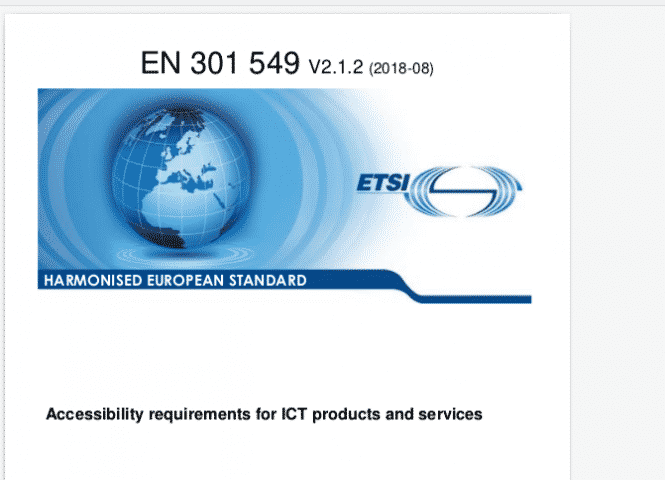
From Kiosk Association kma.global site March 2021
Update for Europe ADA
New draft changes went in 3/19/2021 – release is imminent of 1.1.2 updated. We thought it a good time to bring this back into focus for the self-service community.
What is Europe ADA
EN 301 549 “Accessibility requirements suitable for public procurement of ICT products and services in Europe”
Where are the documents for EN 301-549
They are managed at ETSI
Are they the same as US ADA?
They share some identical influences such as WCAG but they are not the same. An update on the WCAG standard is the release of the working draft for WCAG 3.0. One of the goals of the U.S. Access Board is to “harmonize” the disparate standards into one standard. The European standards have been described by some as in certain cases more descriptive in effect. By contrast the US standards are sometimes described as more prescriptive. There are many areas that though that they directly harmonize with each other.
What Does EN 301-549 Say About Braille?
Not very much actually. It is included in the definition of assistive technology — assistive technology: hardware or software added to or connected to a system that increases accessibility for an individual NOTE 1: Examples are Braille displays, screen readers, screen magnification software and eye-tracking devices that are added to the ICT.
Do European Standards Specifically Mention “Kiosks”
Yes. In one sentence in definitions. Information and Communication Technology (ICT): technology, equipment, or interconnected system or subsystem of equipment for which the principal function is the creation, conversion, duplication, automatic acquisition, storage, analysis, evaluation, manipulation, management, movement, control, display, switching, interchange, transmission, reception, or broadcast of data or information NOTE: Examples of ICT are web pages, electronic content, telecommunications products, computers and ancillary equipment, software including mobile applications, information kiosks and transaction machines, videos, IT services, and multifunction office machines which copy, scan, and fax documents.
Do European Standards Specifically Mention “ATM”
No.
Do European Standards Specifically Mention “POS or Point of Sale or EMV or PCI”
No, however, they do have a section for Receipts and Transactions which has requirements. It seems pretty clear that speech output is required to verify the transaction.
Europe ADA receipt
Comments by Access Board
Throughout its rulemaking process to update its Section 508 Standards, the Board coordinated its work with the European Commission’s development of counterpart ICT accessibility standards. In 2014, the European Commission adopted the “Accessibility requirements for public procurement of ICT products and services in Europe” (EN 301 549) which is available for use by European government officials as technical specifications or award criteria in public procurements of ICT products and services. The Board has worked to ensure broad harmonization between its ICT requirements and the European Commission’s standards (as revised in 2015).
The language you use when describing the qualitative differences between the “European standards” and the “US Standards” appears to be more of an opinion, rather than fact-based. Example: “detailed outcomes and fuzzy requirement” versus “detailed requirements and fuzzy outcomes.” You may be better served by looking at some of the specific provisions in the two standards, EN 301 549 and the Revised 508 Standards (2017) and seeing how the technical requirements are addressed. While the language may differ, the standards still harmonize. For example, both standards have requirements in their respective documents on Hardware. The language used in each of the provisions is similar. The EN text also provides “Notes” which further explain the text of the provision. Another factor you might consider when doing an evaluation between the two standards is the context in which they are drafted. The U.S. 508 Standard is fairly focused on defining and addressing the accessibility features of ICT, with an intention of implementing this is procurements as well as operations. The EN standards address ICT accessibility features AND also address services, such as “Relay Services requirements” in Chapter 13 “ICT providing relay or emergency service access”.
See: Revised 508 Standards(2017) : 406 Standard Connections https://www.access-board.gov/ict/#406.1
406.1 General
Where data connections used for input and output are provided, at least one of each type of connection shall conform to industry standard non-proprietary formats.
Compared to: EN 301 549 v3.2.1 (2021-03) https://www.etsi.org/deliver/etsi_en/301500_301599/301549/03.02.01_60/en_301549v030201p.pdf
8.1.2 Standard connections
Where an ICT provides user input or output device connection points, the ICT shall provide at least one input and/or output connection that conforms to an industry standard non-proprietary format, directly or through the use of commercially available adapters.
NOTE 1: The intent of this requirement is to ensure compatibility with assistive technologies by requiring the use of standard connections on ICT.
NOTE 2: The word connection applies to both physical and wireless connections.
NOTE 3: Current examples of industry standard non-proprietary formats are USB and Bluetooth.


